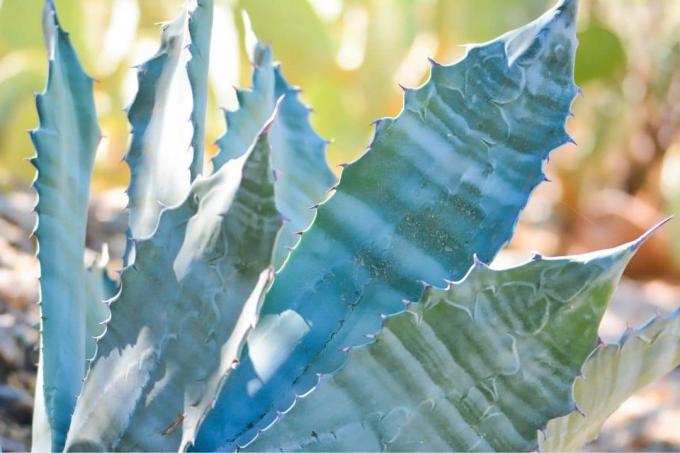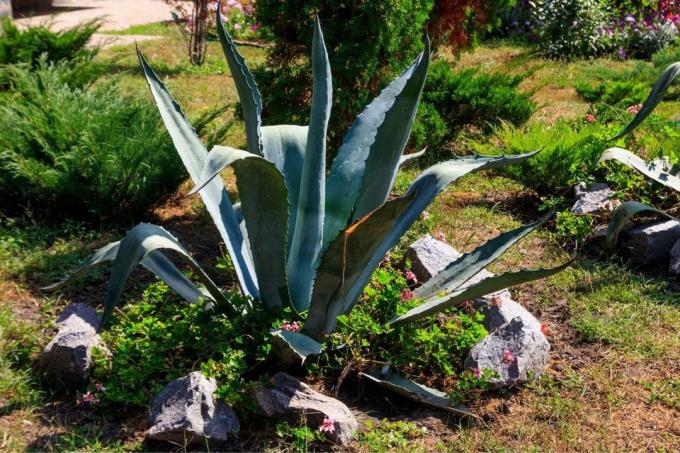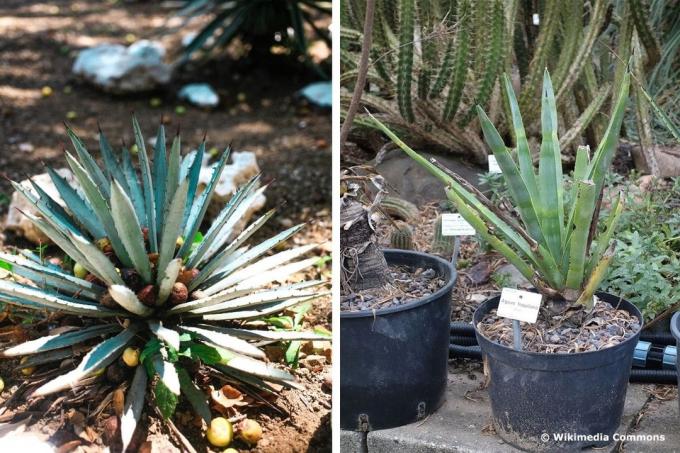
table of contents
- Characteristics
- Location & substrate
- to water
- Fertilize
- Bucket culture
- Cutting & overwintering
- Repot
- Multiplication
- Common care mistakes
- Diseases & pests
- frequently asked Questions
The blue agave is a comparatively undemanding plant that does not require a lot of care. Still, there are a few things to look out for in the culture. Our guide shows what is important.
In a nutshell
- Agave is native to South America
- Blue agave is used to make tequila
- is also suitable as a houseplant
- remains comparatively low
- can grow very wide
Characteristics
Botanical name: Agave tequilana
Height: 30 to 50 centimeters
Broad: about 120 centimeters
Leaves: long, fleshy and up to twelve inches wide
Blossom: blooms only after several decades
Toxicity: non-toxic
Hardy: Winter hardy down to minus 15 ° C

Location & substrate
The agave grows in its area of origin at very high altitudes of up to 2000 meters above sea level. That is, the location should be bright and warm, but does not need protection from the wind. Only water should be able to drain off well, provided the plant is also exposed to rain.
In summer, the plant can also stand outdoors. Again, the location should be bright and warm. A covered balcony or terrace is best.
In the case of the substrate for the agave, particular attention must be paid to its permeability. For example:
- Potting soil mixed with gravel, sand or lava granules
- Cactus soil
- Succulent soil

In addition, a drainage layer should urgently be introduced so that waterlogging is reliably prevented.
to water
When watering, the tequila agave is also easy to care for and is ideal for people who are often on the move or who occasionally forget to water. Because the plant can tolerate drought without any problems, as long as there is still enough water stored in the leaves.
Nevertheless, a few points must be taken into account when giving water. These are:
- If cultivated indoors, water every ten to 14 days
- Do not wet leaves
- water about once a week outdoors in summer
- Calcareous water can be used
- Avoid waterlogging as a matter of urgency
- immerse or soak penetratingly
Note: Hard water containing lime is tolerated, but it is still not the best choice. Collected rainwater, stale tap water and water from an aquarium or pond are therefore more suitable.
Fertilize
The nutrient requirement of the agave is comparatively low. Therefore only succulent fertilizer should be used. Also pay attention to the following points:
- April to September
- once a month
- ideally use liquid fertilizer
The last additional nutrient administration takes place in September at the latest. Otherwise the plant cannot prepare itself adequately for winter.

Tip: It is best to use liquid fertilizer that can be added directly to the irrigation water.
Bucket culture
Since the blue agave is only partially hardy, it should only be planted outdoors in very mild regions. Cultivation in a bucket is recommended for harder winters. However, you must then make sure that you adapt the maintenance accordingly.
This includes watering more often and repotting annually. If the vessels are large enough, an interval of two years is sufficient. Because of the small amount of substrate, the soil is used up faster and is also dried out in a shorter time.
When cultivating in a bucket, it is important to ensure that the planter meets a number of criteria. These are:
- sufficient size
- stable material
- Stability
Tip: Since this results in a high weight, a plant trolley is recommended. Otherwise the transport will be made much more difficult.
Cutting & overwintering
A cut is only necessary for two reasons. On the one hand, when leaves die off. However, you should then wait until the individual shoots are completely dry.
The second reason is the jagged edges on the leaves. They can be removed in the spring to avoid injury.

In any case, it is important to use clean and sharp cutting tools when cutting.
the Wintering the agave is best done indoors, at temperatures of 10 to 15 degrees Celsius. During this time, the blue agave needs less water. Watering every two to three weeks is usually sufficient. The soil should have enough time between waterings to dry off.
There is no fertilization at all during winter. A bright place is still necessary, however. Suitable places are therefore:
- Entrance hall near the window
- bright and frost-free cellar room
- unheated garage
- Winter garden
Repot
The change of soil and planter is always necessary when:
- Earth is used up or is compacting
- Grow roots out of the pot
- there is no longer any stability
The measure takes place in spring. The following procedure is recommended:
-
Protection and safety: Due to the prickly leaf margins, handling the blue agave is difficult. You should therefore either cut the thorns off or wear stab-resistant work gloves to avoid injuring yourself. In the case of large specimens, it is also advisable to repot with two people.
-
Remove old earth: In order to keep the risk of diseases and pests low, the old substrate should be thoroughly removed. Rinsing off the root ball is recommended.
-
Remove leaves: Dead leaves are easier to reach and remove when the plant can be put down. If this measure is necessary, the right time has come during repotting.
-
Insert drainage: A drainage layer is placed at the bottom of the bucket. This can consist of coarse gravel, stones or ceramic shards. It prevents waterlogging and thus the rot and death of the roots.
-
Fill in soil: After the drainage, enough substrate is added so that the stem axis is flush with the surface of the earth. Then the plant is inserted and the bucket is filled up all around. The earth should be pressed several times so that it does not sink in during the final step.
- Water: The blue agave also needs sufficient liquid for the roots to grow and spread well. Therefore, penetrating watering should be done after repotting.

Multiplication
The blue agave reproduces itself by forming so-called kindels. These are offshoots that grow right next to the mother plant. They can be carefully separated when repotting and put in their own pots.
So that the tequila agave can develop daughter plants at all, the roots need sufficient space in the tub. Therefore, always make sure to choose a sufficiently large container.
Also, be patient. It can take a few years for the first children to show up.
Common care mistakes
Agaves are resilient and therefore do not take damage too quickly. Nevertheless, there are serious mistakes in maintenance that can lead to significant problems. Typical and therefore widespread are:
- chemical burns on the roots
- wrong pouring
- Putrefaction from waterlogging
- Overfertilization
- too dark location or too warm location in winter
- too little substrate
Cracks and discoloration of the leaves can arise, for example, if you wet the shoots while watering or if the plant is too moist and cannot dry off quickly enough.

An apparently inexplicable approach, on the other hand, can be explained by the fact that the agave is either insufficiently supplied with nutrients or there are too many of them in the soil.
In the event of such problems, you should therefore first check the care conditions.
Diseases & pests
Neither germs nor parasites are often found on the blue agave. If this is the case, the problems can usually be traced back to errors in the culture. Because these lead to the weakening of the plant.
frequently asked Questions
Otherwise it does not pause for growth and is thus weakened. It becomes more fragile and its lifespan can be shortened.
For children and pets in particular, they can be a danger, but they can also be a problem when repotting. It is therefore better to set up the plant in such a way that there is no direct contact. Alternatively, the spines can be cut off.
After the harvest, which can only take place in an eight to nine year old plant, the heart is cooked under steam for one to one and a half days. Subsequent fermentation turns it into tequila.
Due to the expansive shape, some of the older shoots can become a nuisance over time. This of course tempts you to shorten it. However, this poses two problems. On the one hand, it doesn't look very appealing. On the other hand, it creates a wound through which germs or pests can penetrate and the water reservoir of the plant is reduced.
It is therefore better to choose a location that offers enough space.
That is possible but not optimal. The plant loses strength as a result. If you don't have a room with suitable temperatures, you can leave the plant to overwinter in a nursery. Some offer this option.



